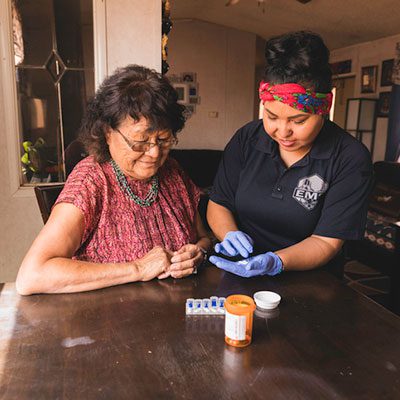The U.S. Department of Health and Human Services Office of Minority Health (OMH) reported in 2019 that 42.1% of citizens identifying as American Indian or Alaska Native relied on Medicaid or other public health insurance, and 14.9% had no coverage at all. Compared to non-Hispanic white individuals in the U.S. — with 34.3% on Medicaid or public health insurance and only 6.3% without coverage — Native American healthcare disparities clearly still exist despite efforts to eradicate them.
Major health challenges for Native Americans stem from lack of access and the effects of social inequities and historical trauma. A deeper understanding of these factors can help healthcare organizations better serve these communities, address the root causes, and ultimately provide more beneficial effects and lasting change.
As a proud member of the Cherokee Nation in Tulsa, Oklahoma, where I grew up and am now raising my own children, I am actively involved in the Native American community. I am also a registered nurse with 15 years of experience and a mid-market account executive in the Government Division for all Tribal Health, Urban Indian Health, and Indian Health Service clients at Relias. I work with healthcare facilities to identify unique healthcare workforce needs and offer innovative solutions for regulatory compliance, hiring and onboarding, staffing and retention, and clinical learning.
In this article, I’ll discuss contributing factors and barriers that impact the overall health and well-being of Native American communities and some of the current critical needs in Native American health care. I’ll also examine some important educational and cultural considerations for successfully moving forward.
Healthcare challenges for Native Americans
Socioeconomic inequality creates challenges for many in the U.S., particularly Native Americans. The violence that is part of our nation’s history caused financial, physical, and mental harms to individuals and families in tribal communities since our country began. And we see the lasting detrimental effects every day in our healthcare systems.
Lack of funding and access
Native American health care faces the constant challenge of finding resources to meet patient needs. Insufficient funding creates a lack of clinical resources because available funding is often put toward direct patient care. Without adequate funding, it is difficult to provide the evidence-based clinical learning that health systems need to both improve the care they provide and serve more individuals who need care.
It is a common misconception that all Native Americans receive health insurance and access to care. Many rely on Indian Health Service (IHS), an agency within the U.S. Department of Health and Human Services that collaborates with tribal leaders to best serve the needs of AI/AN health. IHS provides federally-funded health care to nearly 2.6 million Native Americans — but this number represents less than half of the nation’s AI/AN population. In fact, the AI/AN population has the highest uninsured rate compared to other U.S. populations.
Social and structural inequities
Structural inequities stemming from historical discrimination have led to poor social determinants of health for many Native Americans today. Unemployment and poverty have negatively affected Native American communities across generations. Denial of opportunities for land, housing, education, jobs, and basic resources have created a cycle of poor health and fewer opportunities to overcome it.
Native American and Alaska Native people are arguably one of the most vulnerable and underserved patient populations in the United States. They experience lower life expectancy and disproportionate disease burden, rooted in economic adversity and poor social conditions. IHS reported that this population has a life expectancy that is 5.5 years less than the U.S. population as a whole.
Historical and present-day trauma
In addition to a lack of resources and social inequities, historical trauma is a very real factor for the Native American community. In its Indian Health manual, IHS stated that it, “…acknowledges the role that trauma resulting from violence, victimization, colonization, and systemic racism plays in the lives of American Indian and Alaska Native (AI/AN) populations, specifically AI/AN youth who are two and a half times more likely to experience trauma compared to their non-Native peers.”
The manual includes a chapter on delivering trauma-informed services, which emphasizes the importance of healthcare providers understanding how to effectively serve Native American patients in ways that consider how trauma can affect engagement and outcomes. Providers must also understand how to protect patients and avoid retraumatizing them, as well as implement practices to support well-being and resiliency.
Specific areas of concern in Native American health care
In addition to treating Native American patients in more culturally competent ways, several clinical areas of concern have emerged as critical issues in Native American health.
Heart conditions and diabetes
Social determinants of health unique to 5.2 million Native Americans have contributed to health disparities and disease prevalence, such as heart conditions and diabetes. Native American and Alaska Native adults have the highest prevalence of diabetes, at 14.9% for males and 15.3% for females, often accompanied by peripheral vascular disease. These higher numbers also translate to a greater number of diabetic foot ulcers and amputations.
Opioid misuse and deaths
Social determinants of health are a notable contributor to the opioid crisis that is currently plaguing the Native American community, with 13.7 opioid-related deaths per 100,000 people in the AI/AN population. Over the last two decades, the number of opioid overdoses per year has increased faster than that of the general population — in some studies nearly triple that of non-Hispanic whites.
Mental health and suicide
Suicide within the AI/AN population has become an epidemic, with suicide rates increasing by 20% between 2015 and 2020, compared with a less than 1% increase of suicides occurring throughout the overall U.S. population. Many Native Americans have traditionally held a cultural belief of not speaking about suicide, and many Native American languages do not have a translation for the word suicide.
Maternal mortality and morbidity
One of the most heartbreaking crises occurring in modern health care is that of maternal morbidity and mortality in the AI/AN population. Native American women are experiencing the most rapid increase of maternal mortality over the past decade, ranking second in the nation for the racial/ethnic population with the highest rate of preventable maternal deaths. AI/AN women are three to four times more likely to die of complications during pregnancy or childbirth compared with white women and are two to three times more likely to experience severe maternal morbidity.
Approaches for improving Native American health care
Tribal Health, the Urban Indian Health Program, and Indian Health Service share realistically achievable goals for advancing health care and improving outcomes in AI/AN health. Major organizational initiatives focus on improving Native Americans’ biggest health disparities — including diabetes and related complications, suicide, opioid use disorder and addiction, and maternal health — through policy development, research, funding, and resources for employees to integrate concepts of social determinants of health, cultural competence, mental health, and trauma-informed care models into all aspects of care.
Trauma-informed care training
IHS and tribal health facilities have recently begun to implement trauma-informed services through policy development and learning activities. All staff must complete trauma-informed care training upon hire and then annually to focus on its impact on mental and physical health, promoting resiliency, and interacting with people who may have experienced trauma.
Telehealth for rural communities
To increase access to care for American Indians and Alaska Natives, providers began to incorporate telehealth services during the pandemic and have continued to expand them to provide public health services and primary care to reach rural communities more effectively.
Mental health care to prevent opioid misuse
Tribal and Indian health organizations have focused on increasing mental healthcare access to prevent opioid-related adverse events and achieved some progress. Recent data from 2018 and 2019 showed that prescription opioid misuse decreased in the AI/AN population, except for misuse by youths aged 12-17, which continued to increase.
Patient education initiatives
Congress has appropriated funds for tribal communities through the Special Diabetes Program for Indians (SDPI), recently announcing an additional opportunity (currently accepting applications) for tribal community health organizations to take advantage of available funding for diabetes management. Educating patients on health promoting activities, such as techniques to increase glycemic control, can significantly reduce comorbidity in AI/AN health care.
The holistic solution: multidisciplinary, evidence-based education for clinicians
These and additional health initiatives could be better supported with standardized education that fits multidisciplinary needs, uses evidence-based research, satisfies regulatory requirements, and aligns with current practices and guidelines. In addition, education on trauma-informed care models, mental health, and social determinants of health can improve all services provided.
Personalized learning in multiple modalities
For example, the Relias Obstetrics Solution library offers personalized learning that supports different adult learning styles — meeting learners where they are and building on their current expertise. Courses include embedded simulations to offer innovative and effective methods of learning, providing clinicians with deeper understanding and preparing them to respond to high-risk obstetrical care and emergencies.
Webinars, instructor-led trainings, in-situ simulation events, and presentations from internal subject matter experts are all excellent ways to offer knowledge-building opportunities and clinical practice updates throughout Tribal and Indian Health.
Engaged learning leads to better outcomes
As a nurse educator, I discovered that learners gain more out of learning when it is engaging and meets individual learning needs. There is a direct correlation between education in which learners are engaged and improved performance, leading to more positive outcomes for patients. Implementing an educational intervention in which improvement can be measured, such as with Relias clinical performance solutions, can have a meaningful impact on our ability to address disparities.
I also believe that quality, standardized education proven to enhance patient outcomes in the hands of all multidisciplinary clinicians and paraprofessionals — especially those with limited access to resources and those in rural and remote locations where health disparities are prominent — better prepares the workforce to promote health and address disparities effectively.

Evidence-Based Government Healthcare Training Solutions
Relias can help your government organization improve patient care and outcomes with our proven, data-driven solutions. We support your clinicians on their journey to competency — and your organization’s journey to excellence.
Explore solutions →






